The Emperor's Castle
 [Image: Image 1, "Eternal Punishment," from The Emperor's Castle by Thomas Hillier].
[Image: Image 1, "Eternal Punishment," from The Emperor's Castle by Thomas Hillier].For his student thesis project at the Bartlett School of Architecture, Thomas Hillier produced an immersive narrative world, complete with origami-filled hand-cut book pages and an elaborate model of the story's architectural landscape. Hillier's project was called The Emperor's Castle and it was inspired by the work of Japanese printmaker Hiroshige.
- The Emperor’s Castle originates from a mythical and ancient tale hidden within a woodblock landscape scene created by Japanese Ukiyo-e printmaker, Ando Hiroshige. This tale charts the story of two star-crossed lovers, the weaving Princess and the Cowherd, who have been separated by the Princess’s father, the Emperor. These characters have been replaced by architectonic metaphors creating an urban theatre within the grounds of the Imperial Palace in central Tokyo.
The first two images, Hillier says, are taken from his "research storybook." They are hand-cut paper collages, and they show us "two acts from a series of five that illustrate and explore the narrative structure of the tale." The scenes thus supply "a series of clues, which can inform the future architectural proposition."
 [Image: Image 2, "The Last Meeting," from The Emperor's Castle by Thomas Hillier].
[Image: Image 2, "The Last Meeting," from The Emperor's Castle by Thomas Hillier].As Hillier writes:
- Image 1 (Act 3, Eternal Punishment) illustrates the Emperor’s anger over his daughter’s relationship with a cowherd. He separates the couple, placing them back in their original locations. The Emperor wanted to be sure they would never meet again, so he closed the castle and opened the heavens. Rain fell, causing the castle’s moat to flood, creating an island of the castle surrounded by a deep and swift lake unassailable by any man.
Image 2 (Act 5, The Last Meeting). Seeing the sadness of their friend, the Princess, the birds and animals came together to decide how to stop the torrent of her tears. So the sky became black as all the magpies and crows, with their wings spread wide, formed a bridge across the lake. When the Princess realizes what the birds have done, she stops crying and rushes across the feathery bridge to embrace the Cowherd and renew their pledge of eternal love.
In a way, it's the Hypnerotomachia Poliphili as retold for Late Edo Japan.
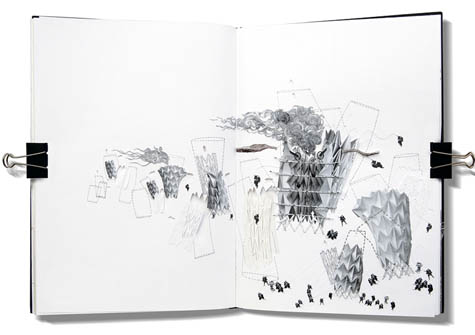

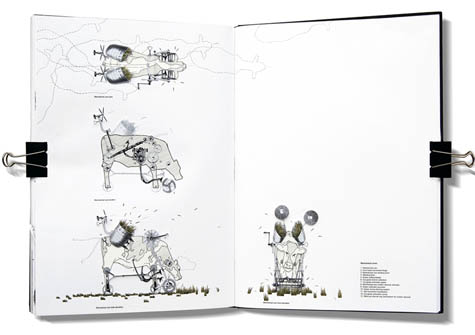 [Images: Image 3, "The Emperor's Origami Lungs"; Image 4, "The Princess's Knitted Canopy"; and Image 5, "The Cowherd's Mechanical Cow-cutters"; from The Emperor's Castle by Thomas Hillier].
[Images: Image 3, "The Emperor's Origami Lungs"; Image 4, "The Princess's Knitted Canopy"; and Image 5, "The Cowherd's Mechanical Cow-cutters"; from The Emperor's Castle by Thomas Hillier].From Hillier's project text:
- Image 3 (The Emperor’s Origami Lungs). The Emperor’s lungs come alive through differing gestures and surface transformations based on geometrical tessellations adopted from origami crease patterns. The lungs imitate the motion of breathing through expansion and contraction creating a bellowing volume that allows the Emperor to project his emotions both visually and audibly. They rise and fall, creating a bobbing motion, which produces a rippling affect onto the surrounding skin. The severity of these ripples will depend on the anger of the Emperor, and can cause the newly knitted areas of skin to become loose and break, stopping the Princess from ever reaching the cow herder.
Image 4 (The Princess’s Knitted Canopy). The Princess, a flexible, diaphanous knitted membrane, envelopes the spaces below and is fabricated using the surrounding ‘Igusa’: a natural rush material used in the fabrication of tatami mats. Igusa expels a soothing scent as the skin undulates, which is said to calm body and mind. This scent acts as a perfume of remembrance to the cow herder and his time spent running hand in hand through the meadows with the Princess.
Image 5 (The Cowherd’s Mechanical Cow-Cutters). The cowherd has been reinterpreted architecturally as the grass band, which wraps the perimeter of the site, encompassing the Emperor’s lungs and Princess’s knitted skin. Embodying the cowherd are the mechanical cows, which act as wind-up grass-cutting devices that constantly wander the grazing land, cutting the grass and fanning the aroma towards the Princess as a reminder of the cowherd. These cows are waiting and hoping for the moment the Princess knits her skin over the mechanical waves towards them, re-enacting the connection between the two star-crossed lovers.
 [Image: Image 6 from The Emperor's Castle by Thomas Hillier].
[Image: Image 6 from The Emperor's Castle by Thomas Hillier].The rest of the images—including the full model, above—showcase Hillier's exquisite craftmanship.
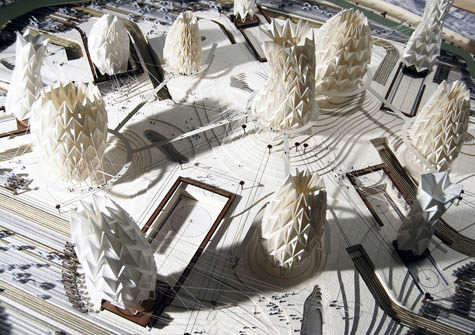
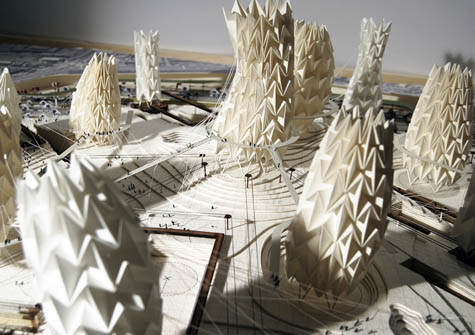

 [Images: Images 7, 8, 9, and 10 from The Emperor's Castle by Thomas Hillier].
[Images: Images 7, 8, 9, and 10 from The Emperor's Castle by Thomas Hillier].Image 7, above, shows us "the contoured landscape underneath the knitted canopy, exposing the series of connecting walkways that allow the Emperor’s army to run from one lung to another," while Image 8 reveals "the Emperor's origami lungs." Image 9 reveals how those lungs operate; there, we begin to see "the lung movements" of the Emperor, Hillier writes, as they "generate a bellowing volume of air." This air is then "forced upwards, sending the woven lung collars into a thrashing frenzy, visually increasing the impact of the Emperor’s anger." In another context, it might be interesting to explore the use of pneumatic metaphors to explore the nature and function of imperial power; but such an essay will have to wait for another day.
Image 10, meanwhile, zooms in on the Emperor's "Mechanical Moat," a machine-hydrology that surrounds and delimits the project landscape.
And then we reach the finale.
 [Image: Image 11 from The Emperor's Castle by Thomas Hillier].
[Image: Image 11 from The Emperor's Castle by Thomas Hillier].The images below are "the final triptych," Hillier writes. They offer "a section through the urban theatre [that] illustrates the frenetic ‘life’ of the building. This 1.8m x 0.8m piece is the culmination of all the research and design synthesis carried out above."
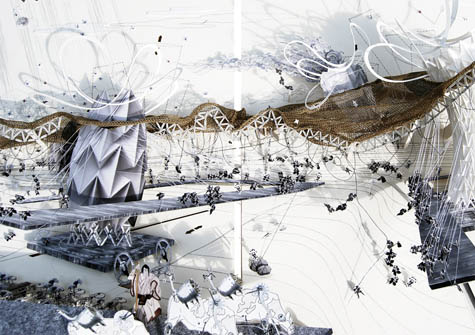

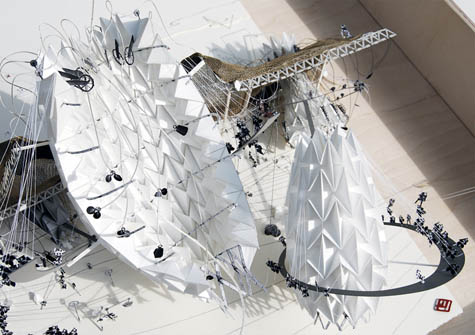
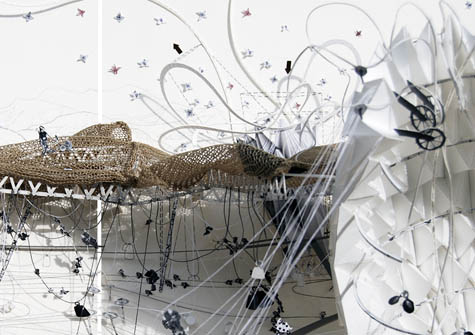 [Images: Images 12, 13, 14, and 15 from The Emperor's Castle by Thomas Hillier].
[Images: Images 12, 13, 14, and 15 from The Emperor's Castle by Thomas Hillier].Hillier's project is a beautifully realized example of something I've long been curious about—for instance, if a book like Ulysses had been "written" not with a typewriter but with a 3D printer, what sort of architectural world might result? The Emperor's Castle offers at least one possible answer for how literature could be translated directly into urban and architectural space.
Now reverse-engineer this: take a landscape garden somewhere—or an accidental assemblage of parks, buildings, rivers, and homes—and interpret that setting as if it is literature. Do a reverse-Hillier, so to speak: start with the landscape and extract characters and motivated dramatic actions from the objects placed within it.
In any case, again, check out the Flickr set for more text and much larger images; and don't miss Johan Hybschmann's "book of space," also produced this year at the Bartlett.





Comments are moderated.
If it's not spam, it will appear here shortly!
A very interesting project.
This kind of method reminds me of Bryan Boyer's "Form Follows Fable" dictum.
I would love to see a transcript of the presentation and the jury's reaction to the project.
It might be interesting to give the same 'accidental assemblage of parks, buildings, rivers, and homes' to different people and see how many different literatures they found therein.
Whether divergence matters or not would probably depend on what kind of literature you were hoping for. When I presented some metaphilosophical work to some fellow postgrads. which argued that if e.g. More's Utopia is a philosophical text, maybe we could read actual places as philosophical arguments, we ended up having a lengthy and inconclusive discussion about what an argument is anyway. I can well imagine similar results emerging if people started reading places under the aspects of literary genres.
This project reminds of Dan Brady's interpretation of Franz Kafka's novel 'The Trail'.
http://www.saatchi-gallery.co.uk/artists/artpages/dan_brady_architectural.htm
See Charles Avery The Islanders
Absolutly Amazing
The reverse engineering of story from space that you mention shows up sometimes in videogames. A recent and great example is Metroid Prime, the first 3d Metroid game. You are dropped into an environment with minimal explicit storytelling. There is an environment to explore, ruins that have been colonize by your enemies and as the game progresses, you stumble into parts of the story and you untangle the history of how things got like they are while at the same time, starring in your own story as you fight your way through the environment.
The Marathon series by Bungie (before they made Halo) remains one of my all time favourite examples of this form, where a story is told through a combination of level environments and computer screens with text written by competing AIs that are vying for control of your actions and the ship itself. That and the alien geometry I was telling you about ads up to one of the best game series ever made.
"The Emperor's Castle offers at least one possible answer for how literature could be translated directly into urban and architectural space."
In that sense, this project isn't entirely dissimilar to ancient creation stories, especially like those told by Indigenous Australians, whereby the relationships and events between people and creatures in turn created land forms, weather patterns, and all natural elements that surround us.
Seeking, extrapolating or even creating these mythologies in which to draw upon, opens a world of limitless exploration.
A beautiful idea for a project, and utterly exquisite execution.
hallo, I am a italian Journalist, I wish I could contact Thomas Hillier. Could you put me in contact with him?
Matteo, can you send me an email: bldgblog (at) gmail. I will put you in touch with Thomas. Thanks!
Does anyone know of more examples or works of architecture as interpretation of narrative or text? I appreciate the few references already made. This is a very interesting topic that hasn't had much exploration.
Post a Comment